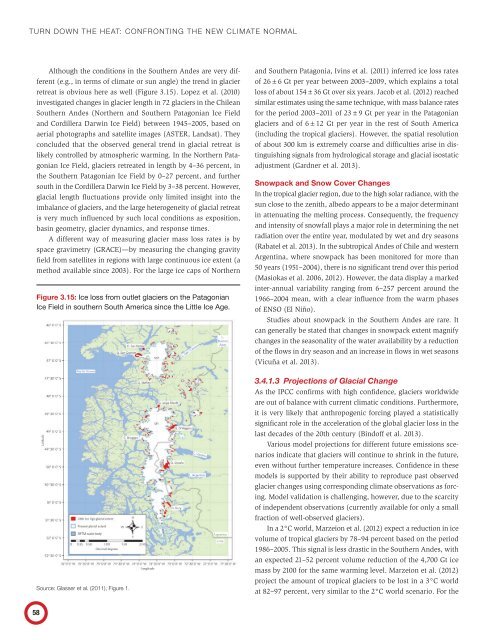1JF6e15
1JF6e15
1JF6e15
You also want an ePaper? Increase the reach of your titles
YUMPU automatically turns print PDFs into web optimized ePapers that Google loves.
TURN DOWN THE HEAT: CONFRONTING THE NEW CLIMATE NORMAL<br />
Although the conditions in the Southern Andes are very different<br />
(e.g., in terms of climate or sun angle) the trend in glacier<br />
retreat is obvious here as well (Figure 3.15). Lopez et al. (2010)<br />
investigated changes in glacier length in 72 glaciers in the Chilean<br />
Southern Andes (Northern and Southern Patagonian Ice Field<br />
and Cordillera Darwin Ice Field) between 1945–2005, based on<br />
aerial photographs and satellite images (ASTER, Landsat). They<br />
concluded that the observed general trend in glacial retreat is<br />
likely controlled by atmospheric warming. In the Northern Patagonian<br />
Ice Field, glaciers retreated in length by 4–36 percent, in<br />
the Southern Patagonian Ice Field by 0–27 percent, and further<br />
south in the Cordillera Darwin Ice Field by 3–38 percent. However,<br />
glacial length fluctuations provide only limited insight into the<br />
imbalance of glaciers, and the large heterogeneity of glacial retreat<br />
is very much influenced by such local conditions as exposition,<br />
basin geometry, glacier dynamics, and response times.<br />
A different way of measuring glacier mass loss rates is by<br />
space gravimetry (GRACE)—by measuring the changing gravity<br />
field from satellites in regions with large continuous ice extent (a<br />
method available since 2003). For the large ice caps of Northern<br />
Figure 3.15: Ice loss from outlet glaciers on the Patagonian<br />
Ice Field in southern South America since the Little Ice Age.<br />
Source: Glasser et al. (2011), Figure 1.<br />
and Southern Patagonia, Ivins et al. (2011) inferred ice loss rates<br />
of 26±6 Gt per year between 2003–2009, which explains a total<br />
loss of about 154±36 Gt over six years. Jacob et al. (2012) reached<br />
similar estimates using the same technique, with mass balance rates<br />
for the period 2003–2011 of 23±9 Gt per year in the Patagonian<br />
glaciers and of 6±12 Gt per year in the rest of South America<br />
(including the tropical glaciers). However, the spatial resolution<br />
of about 300 km is extremely coarse and difficulties arise in distinguishing<br />
signals from hydrological storage and glacial isostatic<br />
adjustment (Gardner et al. 2013).<br />
Snowpack and Snow Cover Changes<br />
In the tropical glacier region, due to the high solar radiance, with the<br />
sun close to the zenith, albedo appears to be a major determinant<br />
in attenuating the melting process. Consequently, the frequency<br />
and intensity of snowfall plays a major role in determining the net<br />
radiation over the entire year, modulated by wet and dry seasons<br />
(Rabatel et al. 2013). In the subtropical Andes of Chile and western<br />
Argentina, where snowpack has been monitored for more than<br />
50 years (1951–2004), there is no significant trend over this period<br />
(Masiokas et al. 2006, 2012). However, the data display a marked<br />
inter-annual variability ranging from 6–257 percent around the<br />
1966–2004 mean, with a clear influence from the warm phases<br />
of ENSO (El Niño).<br />
Studies about snowpack in the Southern Andes are rare. It<br />
can generally be stated that changes in snowpack extent magnify<br />
changes in the seasonality of the water availability by a reduction<br />
of the flows in dry season and an increase in flows in wet seasons<br />
(Vicuña et al. 2013).<br />
3.4.1.3 Projections of Glacial Change<br />
As the IPCC confirms with high confidence, glaciers worldwide<br />
are out of balance with current climatic conditions. Furthermore,<br />
it is very likely that anthropogenic forcing played a statistically<br />
significant role in the acceleration of the global glacier loss in the<br />
last decades of the 20th century (Bindoff et al. 2013).<br />
Various model projections for different future emissions scenarios<br />
indicate that glaciers will continue to shrink in the future,<br />
even without further temperature increases. Confidence in these<br />
models is supported by their ability to reproduce past observed<br />
glacier changes using corresponding climate observations as forcing.<br />
Model validation is challenging, however, due to the scarcity<br />
of independent observations (currently available for only a small<br />
fraction of well-observed glaciers).<br />
In a 2°C world, Marzeion et al. (2012) expect a reduction in ice<br />
volume of tropical glaciers by 78–94 percent based on the period<br />
1986–2005. This signal is less drastic in the Southern Andes, with<br />
an expected 21–52 percent volume reduction of the 4,700 Gt ice<br />
mass by 2100 for the same warming level. Marzeion et al. (2012)<br />
project the amount of tropical glaciers to be lost in a 3°C world<br />
at 82–97 percent, very similar to the 2°C world scenario. For the<br />
58


